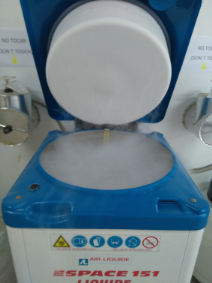- Zebrafish room
Resp. scientific: Joan Galcerán
Technical: Teresa María Gomez Martínez
- Rats
Resp. scientific : Gonzalo Moreno
- Animal House Mice – RMG zone
More information: Animal housing mice RMG
Resp. scientific: Gonzalo Moreno
- Transgenic and cryopreservation services
The Transgenic and Cryopreservation Services offers specialized services of mouse reproductive biotechnology. We perform assisted reproduction techniques (in vitro fertilization) to ensure the preservation of infertile and/or endangered strains, aseptic rederivation by embryo transfer to improve the sanitary status of contaminated strains, import/export of strains with cryopreserved or refrigerated material, cryopreservation and archive of strains, and generation of new genetically modified models by additive classical transgenesis techniques or targeted mutagenesis.
The service has the following specialized equipment:
- Heated dissecting microscopes.
- Classic and benchtop CO2 incubators for In Vitro Fertilization.
- Controlled-rate freezing unit.
- Inverted Microscope with antivibration system, Eppendorf´s micromanipulators and Femtojet injector.
- ESPACE 151 liquid nitrogen tank for safe storage of samples with auto filling system.
The services we offer are:
- Sperm and Embryo Cryopreservation.
- In vitro fertilization (IVF).
- In vivo sampling of epididymal sperm.
- Aseptic rederivation by embryo transfer.
- Strain rescue.
- Strain speed expansion through IVF.
- Revitalizing of cryopreserved or refrigerated gametes and embryos.
- Strain Import/Export by sperm, embryos or epididymis.
- DNA or RNA pronuclear/cytoplasmic microinjection.
Cryopreservation offers the opportunity of archiving valuable laboratory mice strains such as inbred or genetically modified mice, slowing down the onset of genetic drift and insuring them against any natural or sanitary disaster, mismanagement, reproductive problem, or transgene silencing expression.
 The use of cryopreservation in this area also represents a good opportunity to apply the 3Rs policies, since on the one hand is an indirect method of reduction by avoiding the loss of these lines and therefore avoiding a new investment of animals in its creation, but on the other hand offers the possibility of directly reducing the number of animals used in research by archiving and eliminating strains that are kept alive but nevertheless are not being used. In this sense, cryopreservation is also a mechanism that makes possible the good management of the animal facilities since the elimination of obsolete lines is cost-effective (Table 1) and not only reduces the total maintenance costs of animals, but releases space that is being wasted and could be used by other developing research lines.
The use of cryopreservation in this area also represents a good opportunity to apply the 3Rs policies, since on the one hand is an indirect method of reduction by avoiding the loss of these lines and therefore avoiding a new investment of animals in its creation, but on the other hand offers the possibility of directly reducing the number of animals used in research by archiving and eliminating strains that are kept alive but nevertheless are not being used. In this sense, cryopreservation is also a mechanism that makes possible the good management of the animal facilities since the elimination of obsolete lines is cost-effective (Table 1) and not only reduces the total maintenance costs of animals, but releases space that is being wasted and could be used by other developing research lines.
In short, cryopreservation prevents us from losing our model, ensures its quality, is an opportunity to apply the 3Rs and reduce the number of animals used in research, and is also advisable from an economic and management point of view.
Table 1. Ratio of Laboratory mice strains maintenance costs depending on whether they are kept alive or cryopreserved.
 The Transgenic Service of the Institute of Neurosciences CSIC-UMH provides support to researchers for the generation and establishment of genetically modified mouse models. Our team offers technical advice on the best strategy to achieve the desired model through additive transgenesis or targeted mutagenesis.
The Transgenic Service of the Institute of Neurosciences CSIC-UMH provides support to researchers for the generation and establishment of genetically modified mouse models. Our team offers technical advice on the best strategy to achieve the desired model through additive transgenesis or targeted mutagenesis.
The laboratory is located inside an SPF barrier and the work is performed under aseptic conditions, ensuring the best health status for the new strains generated.
Technical responsible: Gonzalo Moreno Del Val
email: g.moreno@umh.es »
Technical: Patricia Muñoz Robledano
email: pmunoz@umh.es »
Transgenic and Cryopreservation
Instituto de Neurociencias
Universidad Miguel Hernández – CSIC
Campus de San Juan
Sant Joan d’Alacant
Alicante | España
Tel. + 34 965 23 37 00
(ext. service 9371 / 9408)

 Español
Español